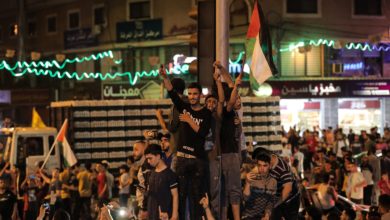Following a
brief hiatus in the wake of the departure of reviled Yemeni President Ali Abdullah
Saleh, mass protests and related government crackdowns have once again
reignited across the country.
In a prerecorded
video delivered on July 7, Saleh remained defiant and appeared unwilling to
give in to the demands of the swelling mass movement that has been raging since
January.
It was the first
public statement Saleh has made since the beginning of June, when he fled to
Saudi Arabia for medical treatment after a bombing of his presidential compound
left him with severe burns over 40 percent of his body.
He has since
been reported to have undergone at least eight operations for his injuries, the
severity of which has renewed questions as to his ability to return to power.
During the statement, Saleh appeared badly burned, with bandaged and immobilized
arms and an uncharacteristic head dress apparently covering further injuries.
Saleh
furthermore refused to mention the U.S.-backed Gulf Cooperation Council deal
that he has repeatedly refused to sign on to. The deal calls for him to step
down in exchange for immunity from prosecution—a measure that has been
resoundingly rejected by the mass protest movement.
Mohammed al-Thahiri, a protest leader from the
capital city of Sana’a, said in response: “We’ll continue our peaceful
revolution until we reach our goals. As for Saleh, his political career is
finished.” (NPR, July 7)
One potential roadblock for Saleh’s return
to power is Article 116 of the country’s constitution. The article states that
if the president for any reason is unable to resume his post, the vice
president is to temporarily take power for up to 60 days and new elections are
to be called. If that were to happen, considering the current political climate
in the country, it would be no easy task to replace Saleh’s administration with
another overtly pro-U.S. puppet government.
“He [Saleh] needs at least one year [to
recover],” said Ahmed Al-Zurqa, a Yemeni political analyst. “His appearance wasn’t his decision. His sons might have put
pressure on him to be televised to prove that he is alive and to gain sympathy
for him. And most importantly, to stop any procedure to transfer power to the
vice president.” (Yemen Times, July 11)
The formation of a transitional council
to replace Saleh was recently announced by opposition groups, including among
its members Ali Nasir Muhammad, an ex-president of the South Yemen socialist
republic. Though the announcement quickly revealed some disagreement among
opposition forces, it was indicative of unity on one question: Saleh must go.
Renewed upsurge in violence following
Saleh address
Following a
relative respite since Saleh’s departure, this month has seen renewed
resistance from opposition forces as well as repressive state violence.
Immediately
following Saleh’s July 7 address, opposition forces once again took to the
streets to demonstrate their continued demand for his ouster. At least 11 people
were killed and over 200 injured throughout Yemen as pro-Saleh forces opened
fire on protesters.
In Sana’a, Mohammed Kamal, a doctor at
al-Jumhuri hospital, counted five dead and as many as 100 wounded. Dozens more
were wounded and killed by pro-Saleh forces in the northwestern city of Hajja,
the western port city of Hodeidah and the southwestern city of Ibb, near Taiz.
Many casualties
are claimed by government sources to be the result of pro-Saleh “celebratory
gunfire,” a claim the corporate media has widely disseminated. However, the
accounts of countless Yemeni activists contradict this claim, saying the deaths
are instead the result of outright murder perpetrated by government forces.
In the city of
Taiz, dozens more people have been killed by pro-Saleh forces. In the center of
the city, security forces have used heavy artillery, including shelling and
mortar attacks.
“They are shooting
randomly and civilian homes are getting damaged. We are afraid,” said Hamood
Aqlan, a doctor in Taiz. (The New York Times, July 15)
However, in
spite of the stepped-up violence of the pro-Saleh forces, thousands of
demonstrators courageously took to the streets to protest in cities all across
the country on July 15.
Washington pulling
the strings
Yemen’s so-called “stability”—meaning the stability of U.S. interests
and political influence over Yemen—has become an increasing concern in recent
years. The United States has been conducting airstrikes since at least 2009,
and in the last five years has provided upwards of $250 million in military aid
alone. (The New York Times, July 8)
Over the weekend
of July 9 and 10, the Obama administration’s top “counterterrorism” advisor,
John O. Brennan, met with Saleh in Saudi Arabia. Brennan renewed calls for Saleh to sign onto the GCC deal,
claiming additional U.S. aid would become available if he were to do so. Saleh
and Brennan have maintained conspicuously close relations in recent years,
particularly since the mass protests broke out in January.
As part of its
overall strategy to perpetually dominate the region, the U.S. military has
recently expanded its aerial warfare in Yemen. According to The New York Times, “[T]he
Obama administration has escalated a campaign of airstrikes carried out by the
Pentagon’s Joint Special Operations Command with the assistance of the C.I.A.”
(July 14)
It has also been
recently disclosed that the C.I.A. is building a secret air base at an
undisclosed location in the region to serve as a staging ground for future
operations in Yemen. The new base is in direct response to the uncertainty of
the United States’ ability to maintain political domination in the region in
the wake of the ongoing Arab revolutions.
Most recently,
at least eight people were killed in Al Wadyia, in Abyan Province in southern Yemen on July 14 when U.S. drones and fighter
jets struck targets. (The New
York Times, July 14)
Clearly, it is a
high-stakes game for Washington—but it is no less so for the Yemeni masses, whose
national sovereignty and independence from imperialist domination are on the
table.





